

Detroit’s Fight Against Blight. At one level, a new report about blight in Detroit can be seen as a cartographic inventory of the abandoned homes, vacant lots and rundown industrial sites that have spread through the once-thriving Motor City like a metastasized cancer.
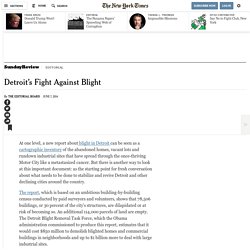
But there is another way to look at this important document: as the starting point for fresh conversation about what needs to be done to stabilize and revive Detroit and other declining cities around the country. The report, which is based on an ambitious building-by-building census conducted by paid surveyors and volunteers, shows that 78,506 buildings, or 30 percent of the city’s structures, are dilapidated or at risk of becoming so.
An additional 114,000 parcels of land are empty. At its peak in 1950, Detroit was home to 1.85 million people; it now has 700,000 residents. Drop Dead, Detroit! For the past twenty-one years, L.

New (and Old) Frontiers: Above Detroit With Aerial Photographer Alex MacLean. Alex MacLean has seen Detroit from the sky at various stages since 1980.

The large green-spaces below, for example, were once crowded neighborhoods and business districts in a city’s footprint that is large enough to fit Houston, Boston and Manhattan. These grassy fields seen from Google Maps might be mistaken for parks. Brush Park to Downtown Detroit, MI. © 2015 Alex S. MacLean/New York Times Similar green spaces a few miles north of town generally have bunkers and greens fees. Golf Community Homes, Rochester Hills, MI. © 2015 Alex S. Black flight to suburbs masks lingering segregation in metro Detroit. Nearly a half century ago, as Detroit licked its wounds following the violent uprisings of 1967, the national Kerner Commission bemoaned the sad state of segregation in America’s central cities and the housing woes endured by African Americans and the urban poor.
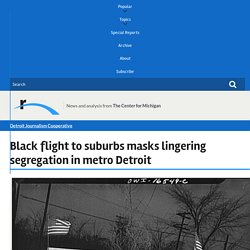
And few regions suffered worse from the separation of races than Detroit. Forced by federal housing policy and local practices into slums and nearly all-black neighborhoods, African-Americans lived apart from the city’s white population, which limited their ability to enroll in better schools in white neighborhoods or seize job opportunities across the city or suburbs. A year after the fires of that summer, the commission, appointed by President Lyndon B. Johnson to examine the causes of riots across dozens of U.S. cities, recommended several policy changes to lessen segregation in low-income housing. They included: While U.S. Together but apart Detroit is now 82 percent African-American, roughly double its presence in 1967. The Old Neighborhood.
Whites moving into Detroit, blacks moving out as city shrinks overall - Crain's Detroit Business. '8 Mile' director Curtis Hanson's love letter to Detroit. A few months after "8 Mile" came out, then-Free Press publisher Heath Meriwether wrote a column reflecting on Detroit (and Eminem) through the prism of the film.

In reply, director Curtis Hanson wrote a letter to the editor reacting to the column. Hanson, who won a screenwriting Oscar for "L.A. Schools of choice creating white flight in metro Detroit. White Flight and Segregation - The Atlantic. Nearly 50 years ago, after a string of race-related riots in cities across America, President Lyndon B.

Johnson commissioned a panel of civic leaders to investigate the underlying causes of racial tension in the country. The result was the Kerner Report, a document that castigated white society for fleeing to suburbs, where they excluded blacks from employment, housing, and educational opportunities. The report’s famous conclusion: “Our nation is moving toward two societies, one black, one white—separate and unequal.” Much of America would like to believe the nation has changed since then. The election of a black President was said to usher in a “post-racial era.”
But now, a new report calls into question that much-vaunted progress. “We’re more negative than other researchers who see declines in segregation,” Daniel Lichter, the lead author and a sociologist at Cornell, told me. Previous data has suggested that segregation between black and white populations is declining. Escape From Detroit: The Collapse of America’s Black Metropolis, by Paul Kersey - American Renaissance.
Escape From Detroit: The Collapse of America’s Black Metropolis by Paul Kersey 374 pages, SBPDL Books, $12 We last checked in with Paul Kersey with his earlier book Hollywood in Blackface, an exploration of the radically different realities of race in movies, and in the physical world.
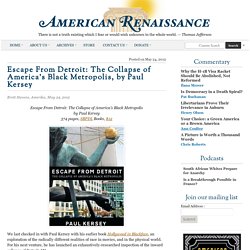
For his next venture, he has launched an exhaustively-researched inspection of the inward collapse of Detroit, MI. Whether Kersey is right or not distills to a question of root causes. Whites moving to Detroit, city that epitomized white flight. DETROIT — Whites are moving back to the American city that came to epitomize white flight, even as blacks continue to leave for the suburbs and the city’s overall population shrinks.
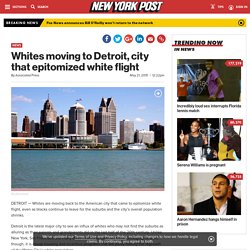
Detroit is the latest major city to see an influx of whites who may not find the suburbs as alluring as their parents and grandparents did in the last half of the 20th century. Unlike New York, San Francisco and many other cities that have seen the demographic shift, though, it is cheap housing and incentive programs that are partly fueling the regrowth of the Motor City’s white population.
“For any individual who wants to build a company or contribute to the city, Detroit is the perfect place to be,” said Bruce Katz, co-director of the Global Cities Initiative at the Washington-based Brookings Institution. “You can come to Detroit and you can really make a difference.” “A young person can move here with $10,000 and start up a small flex space for artists or artists’ studios,” Seger said.
Elizabeth St. St. What became of Detroit? Detroiturbex.com - The 8 Mile Wall. The 8 Mile Wall On the north side of Detroit, there is a concrete wall.
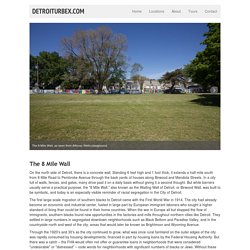
Standing 6 feet high and 1 foot thick, it extends a half-mile south from 8 Mile Road to Pembroke Avenue through the back yards of houses along Birwood and Mendota Streets. Marilyn Salenger: ‘White flight’ and Detroit’s decline. By Marilyn Salenger By Marilyn Salenger July 21, 2013 Marilyn Salenger is president of Strategic Communications Services and a former correspondent and news anchor for several CBS stations.

An almost palpable sadness has swept across the country at the news that the city of Detroit has filed for bankruptcy. While the possibility of this had been discussed, the reality of what was once the fourth-largest city in the United States sinking to such depths is disheartening, a moment people will remember for years to come. To understand that the decline and bankruptcy represent so much more than dollars and cents requires a step back to a time that many would prefer to forget but remains unforgettable. MSNBC guest: ‘White flight’ happened in Detroit because black mayor told whites to leave town. The Downfall of Detroit: White Flight and the 1967 Race Riots. The 1967 Detroit riot, also known as the 12th Street riot, was a civil disturbance in Detroit, Michigan that began in the early morning hours of Sunday, July 23, 1967. The precipitating event was a police raid of an unlicensed, after-hours bar then known as a blind pig, on the corner of 12th (today Rosa Parks Boulevard) and Clairmount streets on the city’s Near West Side.
Police confrontations with patrons and observers on the street evolved into one of the deadliest and most destructive riots in United States history, lasting five days and surpassing the violence and property destruction of Detroit’s 1943 race riot, which occurred 24 years earlier. To help end the disturbance, Governor George Romney ordered the Michigan National Guard into Detroit, and President Lyndon B. Johnson sent in Army troops. The result was 43 dead, 467 injured, over 7,200 arrests, and more than 2,000 buildings destroyed (Rutgers.edu). Works Cited Feagin, Joe R..
Like this: Like Loading...